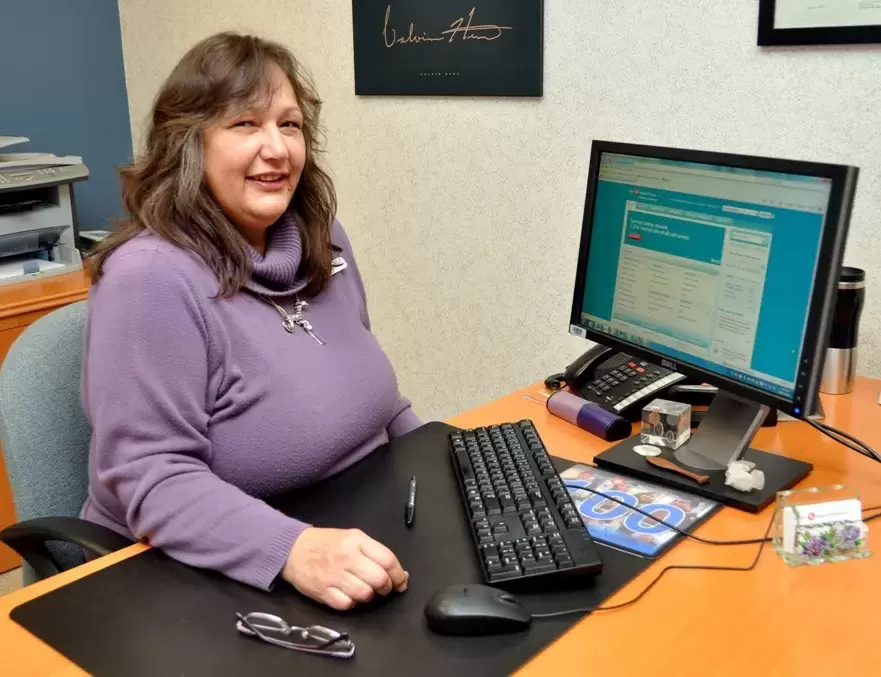Denise Martineau is moving on after serving four years as manager of the Tsahaheh Branch of the BMO Bank of Montreal.
Martineau will wrap up this chapter of her career on Friday, and next week she begins training for a new role as a commercial account manager.
“I report to Nanaimo on Monday,” she said. “The bank is putting me through a training program that will be six to nine months.”
It will be a second career stop in Nanaimo for Martineau.
Martineau is Cree from Frog Lake, Alta., but grew up in Calgary with little connection to her aboriginal heritage. She now says her own personal journey of discovery parallels her employer’s pioneering efforts in the field of aboriginal banking.
Martineau’s banking career began in Strathmore, east of Calgary, in the 1980s, where she began meeting clients from the Siksika First Nation.
“It’s one of the Blackfoot Nations, and these clients began suggesting I work at the Bank of Montreal. They had a branch in Siksika,” she said.
The Bank of Montreal began its aboriginal banking program in 1992 when it hired stockbroker Ron Jamieson as its first vice-president for aboriginal banking.
“He started a task force that went across the country asking people what they wanted in an on-reserve bank,” Martineau said. “I joined Bank of Montreal in 1998. I’m pretty passionate about aboriginal banking.”
Part of that passion is the result of her own quest to connect with her aboriginal heritage, she explained.
“I didn’t have [Indian] status when I was young. All of my aboriginal status is through women,” Martineau said. Status came through Bill C-31 that was enacted in the 1980s when a group of native women fought to have their rights restored after losing it by marrying non-native men.
“That inspired my sisters and me to begin investigating our family history.”
Martineau and her sisters went through several years of researching, followed by a long process of applications.
“We finally got our status in 1998,” she said.
That was the year Martineau applied for and won the manager’s post at the aboriginal bank on the Siksika reserve, which was close enough to commute to from her Strathmore home, but in some ways was a different world than she was used to.
“It was a bit of an eye-opener for me to find out how isolated some people were. That’s when I started to better understand some of the obstacles that people on reserves faced,” Martineau said.
“I was told that part of my role was to give something back to the community, so I started to do educational talks in the community, life skills classes and talks at the high school.”
And the Siksika community gave back, helping Martineau build her own identity as an aboriginal person.
“Understanding who you come from is important, because it helps you understand yourself,” she said.
In 1996, Jamieson visited Port Alberni to officiate at the grand opening of the Tsahaheh Branch on Tseshaht traditional territory. Jamieson spoke passionately of the emerging aboriginal economy and the roadblocks presented by the federal Indian Act, specifically the lack of access to capital, whether on a personal or commercial level. Martineau said the bank has been working to overcome those challenges ever since.
“We’ve been working on developing programs specific to aboriginal people – specifically, an on-reserve housing loan program,” she said. “The Indian Act prohibits us from issuing mortgages on reserve housing.”
While the law is still in place, the bank has found ways to make home loans despite the lack of free title, Martineau said.
After six years at the Siksika branch, Martineau made the decision to move to Vancouver Island.
“I applied for a job in Nanaimo, and when I got there in 2004, I learned about this branch, and I kept my eye on it for the next few years,” she said. “I came here in 2007 because it was a career opportunity, but I discovered what a beautiful place it is. I found that working here on Tseshaht territory, the community has been very open to me, and I have been invited to take part in community events both here and on the West Coast. They have been welcoming and have helped me learn and understand their culture as well.”
As a commercial account manager, Martineau will be in charge of engineering major commercial ventures with clients that include large businesses and organizations, as well as First Nations.
“I could end up based in Nanaimo, which means I could work with some of the same clients I’ve worked with here, but on a commercial rather than an individual basis,” she said.
Martineau said as First Nations pursue an aggressive course of economic development and build new infrastructure and housing on their reserves, they are seeking out a wide range of funding sources. In the Alberni Valley, those sources include the Nuu-chah-nulth Economic Development Corporation, located right across the parking lot from the Tsahaheh branch, but more and more often they are seeking out a commercial bank. One of the goals is to keep the Bank of Montreal as the first choice for aboriginal entrepreneurs and developers.
“We have been a consistent player. We came into the market 20 years ago and we have worked at it consistently,” she said. “We’ve received the gold level rating for Progressive Aboriginal Relations from the Canadian Council for Aboriginal Business for the past four or five years.”
Martineau said she plans to keep her home in Port Alberni and commute during her training period until she finds out where she will be posted.
“I will certainly miss this branch,” she said. “I’ve often told people I feel so lucky to be here. It’s such a beautiful branch. I get to look at the Beauforts out my back window.”
Martineau said her successor has not been announced. In the
interim, assistant manager Sharon Wutke will assume the manager’s duties.







